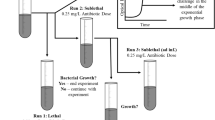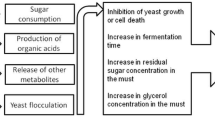Abstract
The addition of penicillin G to combat microbial contamination in continuous fuel alcohol fermentations was performed using both continuous and pulsed addition regimes. In continuous fermentations where both Saccharomyces cerevisiae and Lactobacillus paracasei were present, the mode of addition of penicillin G determined final numbers of viable L. paracasei. When the same overall average concentration of penicillin G was added in both pulsed and continuous modes, the initial viable number of L. paracasei (8.0×109 cfu ml−1) decreased to a greater degree (1.02×105 cfu ml−1 L. paracasei) when penicillin G was pulsed at 6 h frequencies at an overall average concentration of 2,475 U/l than when penicillin G was added continuously at 2,475 U/l (2.77×105 cfu ml−1 L. paracasei). Pulsed additions over longer frequencies at 2,475 U/l were not as effective in reducing viable bacteria. Viable yeasts increased during both treatment conditions by more than 2-fold. The two addition regimes also eliminated the 40% decrease in ethanol concentration caused by the intentional bacterial infection. Although there was 3 times more bacterial death with 6 h pulsed additions compared to continuous additions of penicillin G at 2,475 U/l, there was, by that point, no practical difference in either final ethanol concentration or relative ethanol recovery.




Similar content being viewed by others
References
Aquarone E (1960) Penicillin and tetracycline as contamination control agents in alcoholic fermentation of sugar cane molasses. Appl Microbiol 8:263–268
Bayrock D (2002) Application of multistage continuous culture to VHG-based ethanol fermentations: performance and control of bacteria by pH and pulsed addition of antibiotic. PhD Thesis. University of Saskatchewan, Canada
Bayrock D, Ingledew WM (2001a) Application of multistage continuous fermentation for production of fuel alcohol by very-high-gravity fermentation technology. J Ind Microbiol Biotechnol 27:87–93
Bayrock D, Ingledew WM (2001b) Changes in steady state on introduction of a Lactobacillus contaminant to a continuous culture ethanol fermentation. J Ind Microbiol Biotechnol 27:39–45
Berg C (2002) World production and trade. In: Proceedings of World Ethanol 2002 Conference, 5 November 2002, London, UK
Bischoff KB (1966) Optimal continuous fermentation reactor design. Can J Chem Eng 44:281–284
Chang IS, Kim BH, Shin PK, Lee WK (1995) Bacterial contamination and its effects on ethanol fermentation. J Microbiol Biotechnol 5:309–314
Connolly C (1999) Bacterial contaminants and their effects on alcohol production. In: Jacques KA, Lyons TP, Kelsall DR (eds) The alcohol textbook: a reference for the beverage, fuel and industrial alcohol industries, 3rd edn. Nottingham University Press, Nottingham, UK, pp 317–334
Cysewski GR, Wilkie CW (1978) Process design and economic studies of alternative fermentation methods for the production of ethanol. Biotechnol Bioeng 20:1421–1430
Day WH, Serjak WC, Stratton JR, Stone L (1954) Contamination inhibition: antibiotics as contamination-control agents in grain alcohol fermentations. J Agric Food Chem 2:252–258
Ghose TK, Tyagi RD (1979) Rapid ethanol fermentation of cellulose hydrolysate. I. Batch versus continuous systems. Biotechnol Bioeng 21:1387–1400
Herbert D (1962) Multi-stage continuous culture. In: Malek I, Berans K, Hospodka J (eds) Continuous cultivation of microorganisms. Proceedings of the 2nd Symposium, Czechoslovak Academy of Science, Prague, pp 23–34
Hynes SH, Kjarsgaard DM, Thomas KC, Ingledew WM (1997) Use of virginiamycin to control the growth of lactic acid bacteria during alcohol fermentation. J Ind Microbiol Biotechnol 18:284–291
Ingledew WM, Burton JD (1980) Membrane filtration: survival of brewing microbes on the membrane during storage at reduced humidities. J Am Soc Brew Chem 38:125–129
Kelsall DR, Lyons TP (1999) Management of fermentations in the production of alcohol: moving toward 23% ethanol. In: Jacques KA, Lyons TP, Kelsall DR (eds) The alcohol textbook: a reference for the beverage, fuel and industrial alcohol industries, 3rd edn. Nottingham University Press, Nottingham, UK, pp 25–38
Kheirolomoom A, Kazemi-Vaysari A, Ardjmand M, Baradar-Khoshfetrat A (1999) The combined effects of pH and temperature on penicillin G decomposition and its stability modeling. Process Biochem 35:205–211
Makanjuola DR, Springham DG (1984) Identification of lactic acid bacteria isolated from different stages of malt and whisky distillery fermentations. J Inst Brew 90:13–19
Narendranath NV, Hynes SH, Thomas KC, Ingledew WM (1997) Effects of lactobacilli on yeast-catalyzed ethanol fermentations. Appl Environ Microbiol 63:4158–4163
Narendranath NV, Thomas KC, Ingledew WM (2001) Effects of acetic acid and lactic acid on the growth of Saccharomyces cerevisiae in a minimal medium. J Ind Microbiol Biotechnol 26:171–177
Sinclair CG, Cantero D (1990) Fermentation modeling. In: McNeil B, Harvey LM (eds) Fermentation: a practical approach. Oxford University Press, London, pp 65–112
Stroppa CT, Andrietta MGS, Andrietta SR, Steckelberg C, Serra GE (2000) Use of penicillin and monensin to control bacterial contamination of Brazilian alcohol fermentations. Int Sugar J 102:78–82
Thomas KC, Hynes SH, Ingledew WM (2002) Influence of medium buffering capacity on inhibition of Saccharomyces cerevisiae growth by acetic and lactic acids. Appl Environ Microbiol 68:1616–1623
Tyagi RD, Ghose TK (1980) Batch and multistage continuous ethanol fermentation of cellulose hydrolysate and optimum design of fermentor by graphical analysis. Biotechnol Bioeng 22:1907–1928
Virkajärvi I, Kronlöf J (1998) Long-term stability of immobilized yeast columns in primary fermentation. J Am Soc Brew Chem 56:70–75
Wall JB, Hill GA (1992) Optimum CFST bioreactor design: experimental study using batch growth parameters for Saccharomyces cerevisiae producing ethanol. Can J Chem Eng 70:148–152
Acknowledgements
The authors are grateful for financial support from the Canadian Wheat Board (to D.P.B.), and the Natural Sciences and Engineering Research Council, Chippewa Valley Ethanol Company, Corn Plus, Delta T Corporation, and Alltech Inc. (to W.M.I.). The very capable assistance of Mrs. Sandra Hynes during the course of the project is gratefully acknowledged. The experiments described herein comply with the current laws of Canada.
Author information
Authors and Affiliations
Corresponding author
Rights and permissions
About this article
Cite this article
Bayrock, D.P., Thomas, K.C. & Ingledew, W.M. Control of Lactobacillus contaminants in continuous fuel ethanol fermentations by constant or pulsed addition of penicillin G. Appl Microbiol Biotechnol 62, 498–502 (2003). https://doi.org/10.1007/s00253-003-1324-5
Received:
Revised:
Accepted:
Published:
Issue Date:
DOI: https://doi.org/10.1007/s00253-003-1324-5




